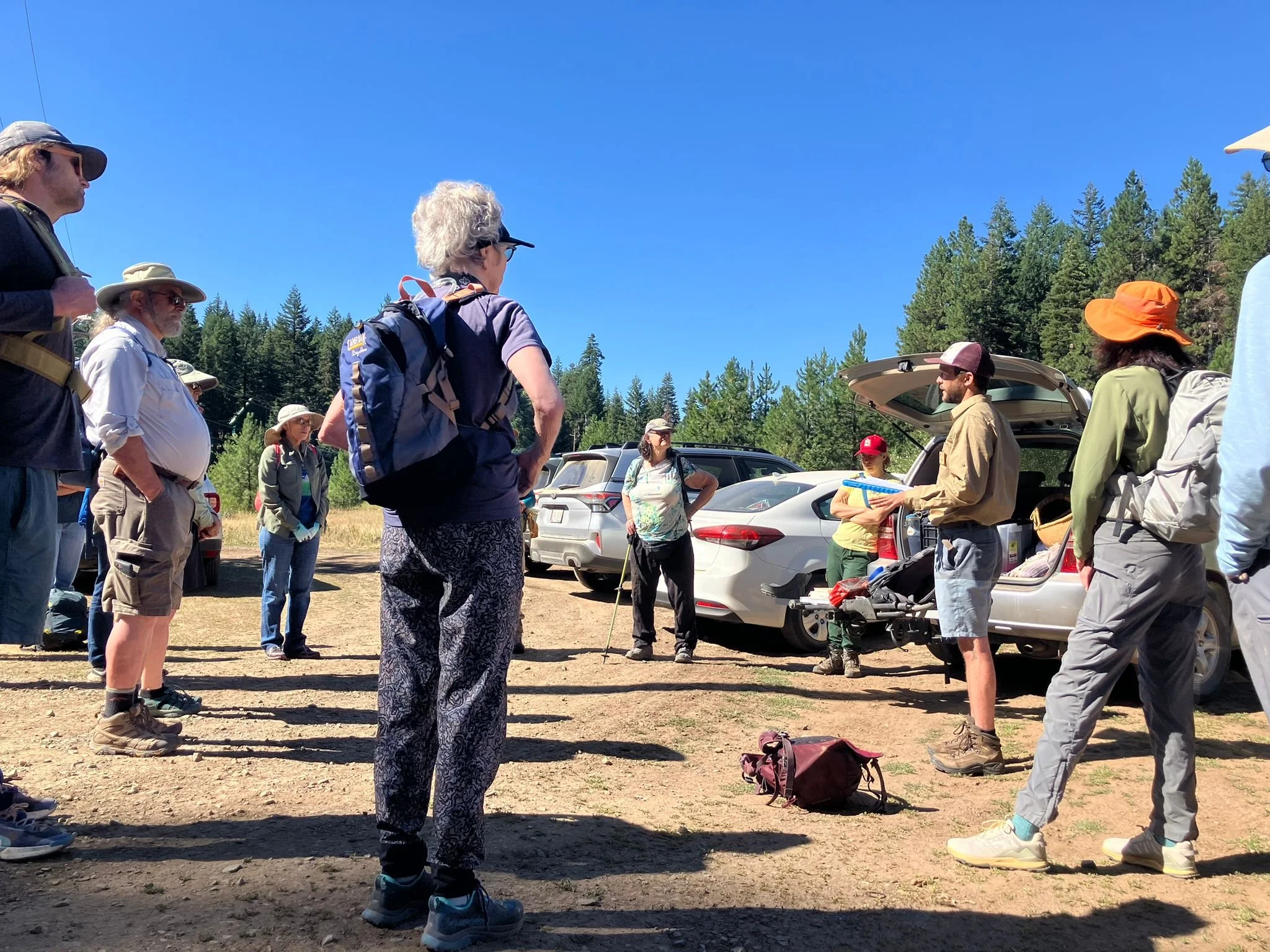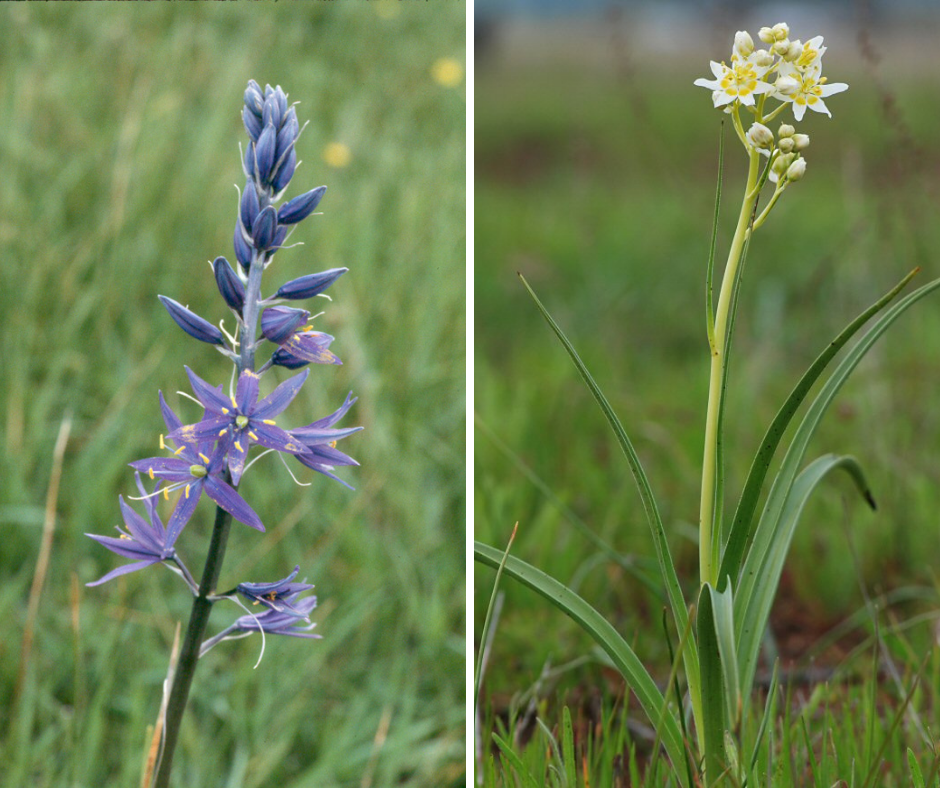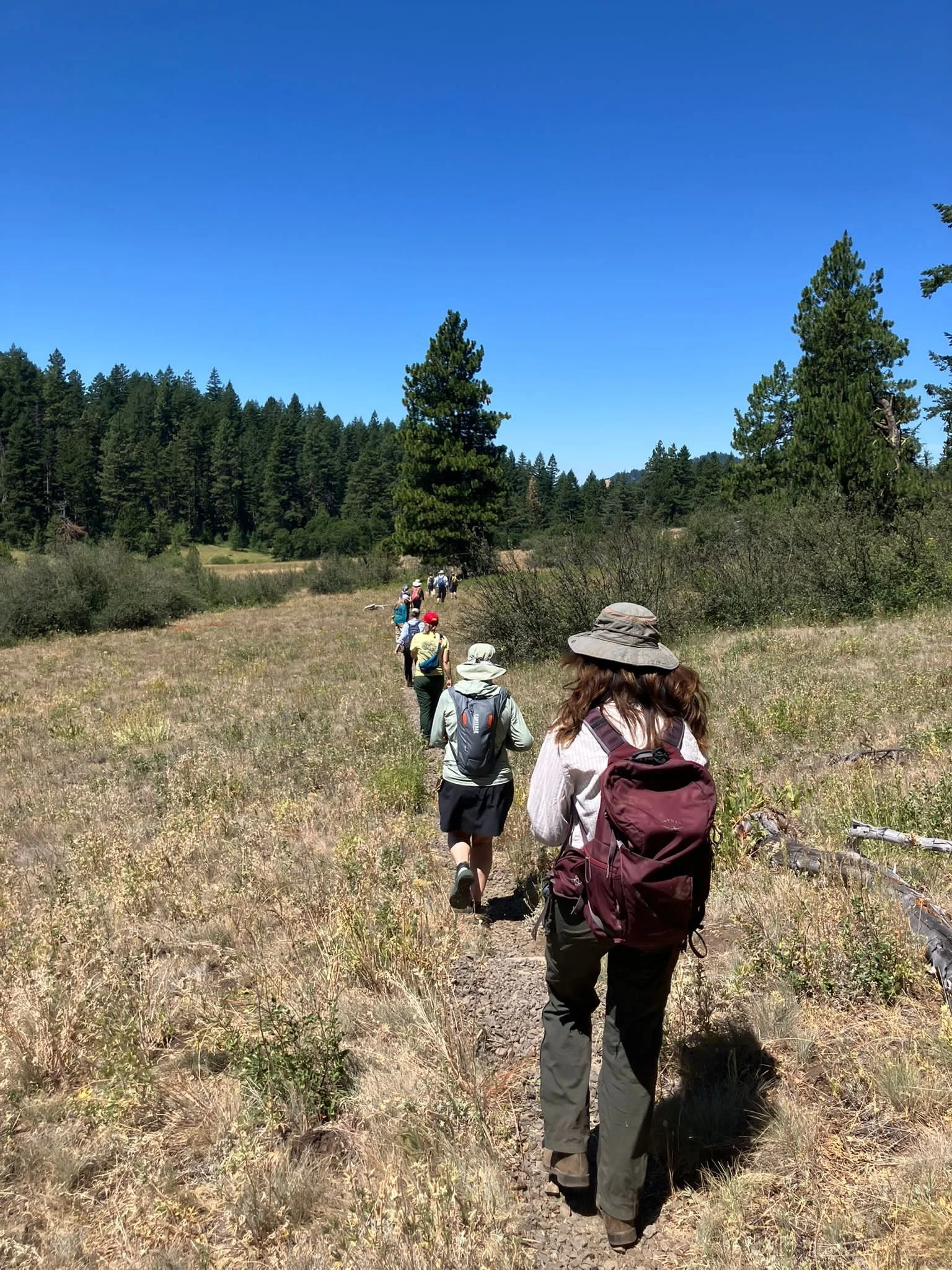Hikers gather with interpretative ranger Jay Ryan sharing indigenous history in the CSNM - PC: Rianna Shiree
On Sunday July 27th, a group of about 15 participants joined Interpretative Rangers, Jay (the writer of this post) and Emma for an ethnobotany hike. The group hiked along the PCT from Little Hyatt Lake, south towards Hyatt Meadows. Along the way we encountered a variety of plant communities, including riparian meadow, mixed conifer forest, oak savannah, and dry meadow. Along the trail we made various stops to discuss ethnobotany, and I am going to share some of them in this post with you today! First, we will give an overview of indigenous removal from these lands, and why many ethnobotany traditions aren’t widely practiced today. Then we will dive into uses of camas and yampa for food, and beargrass and hazel for basketry, followed by discussion on how fire is used to manage landscapes where these plants grow. Lastly we will offer a species list of the plants that we explored on the hike, and some additional resources for finding more information!
Ethnobotany is the study of how indigenous people use plants for cultural purposes, such as food, medicine, basketry, ceremony, and more. Indigenous people have been living in Oregon since time immemorial and using plants for cultural purposes. What we call the Cascade-Siskiyou National Monument is within ancestral territories of the Takelma, Latgawa, Shasta, Klamath, Modoc, and other peoples, all of whom had various ethnobotanical practices. Unfortunately, many of these ethnobotany practices, among other cultural practices such as languages and customs were stolen and criminalized through assimilation and genocide.
Following settler colonialism – to a large extent the gold rush – these groups were forcibly removed from their lands and/or restricted from cultural practices. Due to competition for various resources, such as water, land, and food, settlers drove out native people. Environmental disturbances from livestock and pollution also had significant impacts. For example, Takelma peoples’ camas meadows were destroyed by an abundance of livestock hogs that would dig up the camas bulbs (more on camas later), and Shasta peoples’ salmon fisheries were damaged by effluence from gold mining. Takelma, Latgawa and Shasta people were removed to the Siletz and Grand Rhonde reservations on the coast in NW Oregon. Now the living descendents of the Shasta, Takelma, and Latgawa peoples are members of the Confederated Tribes of the Grande Ronde Indians and Confederated Tribes of the Siletz Indians. The Klamath and Modoc people were removed from their lands and placed on a reservation in the Upper Klamath Basin, which was economically successful through ranching and timber industries, but lost their federal recognition as a tribe and therefore lost their reservation.
For a more thorough history, Please see the tribal websites for the Klamath Tribes, Shasta Nation, and for a history of Takelma and Latgawa, see Confederated Tribes of Siletz, Confederated Tribes of Grand Ronde's webpages, or the BLM’s Publications.
Because these indigenous groups had no written language, through this tragic history of forced removal, assimilation, and outlawing of cultural practices, much of their ancestral knowledge was stolen from them. Despite this, the knowledge and practice of many traditions remain strong today, including ethnobotanic practices.
First Foods: Camas and Yampah
Our first stop was in a riparian meadow adjacent to Keene Creek, downstream of the dam at Little Hyatt Reservoir. Here we found remnants of camas seed pods, and discussed first foods. Foods are means of nutrition as well as a way of life for indigenous people. While plants like camas (Camissia) and yampah (Perideridia) have historically grown abundantly, meadows containing these plants are managed to produce higher yields of foods.
Camas and Yampa are examples of geophytes, or plants that have an underground storage vessel. These are perennial plants that spend the growing season pumping nutrients into these vessels for overwintering. Then, when spring arrives and temperatures warm, the plants have the food they need to put up leaves and flowers right away. We can find many geophytes in the grocery store such as potatoes, carrots, or onions, or in our gardens such as tulips or daffodils. Geophytes come in a variety of forms such as corms (garlic), roots (carrots), bulbs (onions), tubers (potatoes), and rhizomes (ginger).
Left: Camassia quamash (great camas) - PC: Steve Thorstead
Right: Toxicoscordion exaltatum (death camas) - PC: Barry Breckling
Camas, known by many as “indian potatoes” is a starchy tuber with a brilliant blue and purple flower. While a different family entirely, camas tubers and leaves resemble those of death camas (Toxicoscordion exaltatum), which is highly toxic, as the name suggests. When gathering, people wait until the plant has gone into full flower, as the flowers of the plant are distinguishable. Joe Scott, a member of the Confederated Tribe of the Siletz Indians, runs the Traditional Knowledge Inquiry Program (TEIP), and is featured in a Buffalo’s Fire article about camas preparation. In this article, they describe how camas is prepared, first by removing outer papery leaves, then baking in an earthen oven for 1 - 4 days! This converts ⅓ of the starchy mass to tasty fructose. Still, many settler’s accounts of eating camas, like those of Lewis and Clark, have ended in stomachaches and restless nights. While traditional methods are still practiced today, camas is often cooked for several days in a slow cooker.
Periderida bolanderi (yampah) - PC: Gary Monroe
Later in the hike, around lunchtime, we visited a dryer meadow, known as Hyatt Meadows, where another first food, yampah, grows abundantly. Yampah is also a geophyte, this one in the carrot family, Apiaceae. In 2019 the Siletz Tribal Youth Development and Healty Traditions program visited nearby Vesper Meadow to reconnect with tribal traditions, and described their relationship with yampah, a name that comes from the Paiute word ya-pah for “water is here.” Just like carrots, yampah roots are eaten roasted, boiled, raw, or dried. The roots have medicinal use too! An infusion (tea) made from the roots is used to wash sores and wounds and clear mucus. A poultice of roots reduces inflammation, and a poultice of seeds can treat bruises. Chewing on the roots can ease sore throats and coughs. Yampah is harvested during dormant season and stored in sand at a cool 38˚F. According to Mt. Pisga Arboretum, it is harvested in late spring or early summer when the soil is soft. The roots are cleaned at digging sites to ensure rootlets return to the soil. Seeds are also left behind, in hopes that they will germinate. Additionally, to help the plants grow, yampah tenders pull competing species out of the way when digging, and seeds are scattered on the ground during ceremony.
Weaving: Beargrass and Hazel
Midway on the hike we passed through a dense conifer forest, primarily composed of Douglas-fir trees. In the understory, beargrass (Xerophyllum tenax) grows abundantly. Beargrass is a common plant used for weaving baskets that is widespread in North America, and is even traded for outside of its native region. The US Forest Service put out a great report about beargrass, titled Natural and Cultural History of Beargrass. Beargrass’ strong and flexible material makes it good for weaving, but baskets aren’t just for holding things. Basketry is “a sacred practice that is important to maintaining the role of certain entities in our lives and recording our History,” said CHiXapkaid, Skokomish Traditional Bearer of Southern Puget Salish Culture and Professor at Washington State University. Basketry and baskets carry the identities of the families who weave them. Beargrass is also used for regalia in ceremony, but the use of this is less widespread, fairly local to Northern California and Southern Oregon indigenous people. There is an excellent video of how beargrass regalia is used, however the presenter is unnamed (you can see my comment hoping to find the creator). Klamath mountain peoples make braids to hang from dresses and necklaces, to make men’s quivers and aprons, and it is stuffed in headrolls. Additionally beargrass gets wrapped around leather strips with berries and shells attached. These make a lovely shaking sound when worn by a dancer.
Left: Xerophyllum tenax (beargrass) in flower - PC: Keir Morse
Right: beargrass basket - PC: Frank Lake
The abovementioned report on beargrass describes harvest practices as well. Beargrass is best harvested following snowmelt in late spring early summer, with preference for high elevation and low shade leaves, as they are less brittle and more pliable. 3-7 years after wildfire or cultural fire is an ideal time to harvest. Cultural burning promotes rigor and growth of beargrass. Gatherers have a preference for longer, thinner, more pliable leaves that are whitish at the base. Only the longest leaves from mature plants are selected, to keep the plant in good health for subsequent years. Following harvest, leaves are cured in the sun for 1-3 days. Letting them dry for too long will leave them dry and brittle. Often beargrass is dyed with wolf lichen, oregon grape, and other natural dyes, but with modern things as well, such as Koolaid!
While we didn’t see any on the hike, Hazel (Corylus cornuta) is another plant that is used for basketry, as well as food! Hazelnuts are widely consumed and tasty when roasted. Hazel sticks are great for basketry, as they are flexible and rigid. Similar to beargrass, hazel responds well to fire. News outlet KLLC out of Eugene reports on how the TEIP uses fire to manage hazel, interviewing father and son Drew and Jerome Viles. In many places, cultural burning or broadcast fire on the landscape is not possible, because it has been outlawed and/or puts homes at risk. Jerome says, “Hazel has evolved with fire. When burned, plants sent up long, straight shoots.” His father, Drew says that “Hazel likes to be coppiced, or cut, it puts up good shoots after it’s been coppiced. Good sticks come two years after burning.”
Corylus cornuta (hazel) - PC: Keir Morse
Beginning of a hazel basket - PC: Bill Barr, KLLC
The aforementioned plants: camas, yampah, beargrass and hazel, have all been managed by cultural burning for millennia. Many camas and yampah meadows were formed during glaciation, and periodically were burned to keep them open and free from conifers. Similarly, beargrass and hazel rely on burning to put up fresh leaves or stalks. When indigenous people were forcibly removed from the landscapes, cultural burning was outlawed, and a paradigm of fire suppression existed in our forests, these plants suffered from a loss of these ecological forces they relied upon for growth. Today, cultural groups such as TEIP, Lomakatsi Restoration Project, Cultural Fire Management Council, and the Rogue Valley Prescribed Burn Association work in the Klamath, Siskiyou, and Cascade mountains to advocate for and implement cultural burning, prescribed burning, and fire mimicry. We encourage you to visit these sites and advocate for a return of fire for cultural and ecological purposes.
These four plants were just a few plants that we discussed on the hike, for a complete species list, see below!
Species List
Forbs
Achillea millefolium (yarrow)
Camassia leichtlinii, C. quamash (camas)
Lomatium spp. (biscuit root)
Perideria spp. (yampah)
Potentilla gracillis (slender cinquefoil)
Wyethia angustifolia (mule’s ears)
Xerophyllum tenax (beargrass)
Shrubs
Amelanchier alnifolia (serviceberry)
Arctostaphylos uva-ursi (bearberry, kinnikinick)
Corylus cornuta (hazel)
Mahonia spp. (oregon grape)
Sambucus mexicana (blue elderberry)
Salix spp. (willow)
Trees:
Alnus rubra (red alder)
Calocedrus decurrens (incense cedar)
Pinus ponderosa (ponderosa pine)
Pseudotsuga menziesii (Douglas-fir)
Quercus kellogii (black oak), Q. garryana (white oak)
Further Reading
For more information on ethnobotany and indigenous land management, see the following sources that I consulted for my research on this walk!
BRIT Ethnobotanical Database - a website where you can search for any plant and see documented ethnobotanical uses.
Iwígara - a book describing cultural uses of various plants across North America
Tending the Wild - a book discussing native american land management in California
And feel free to make a google search about any plant you’re interested in. Unfortunately knowledge of many cultural uses have been stolen and were never recorded on paper when indigenous people were outlawed from speaking their native tongue. However, there is a lot of information out there, and I encourage you to go look for it!
At the end of the day, the participants walked away with a head full of knowledge and fresh perspectives about the landscapes they reside on and around.
Hikers return to the trailhead, contemplating the vast uses for our native plants. - PC: Rianna Shiree.







